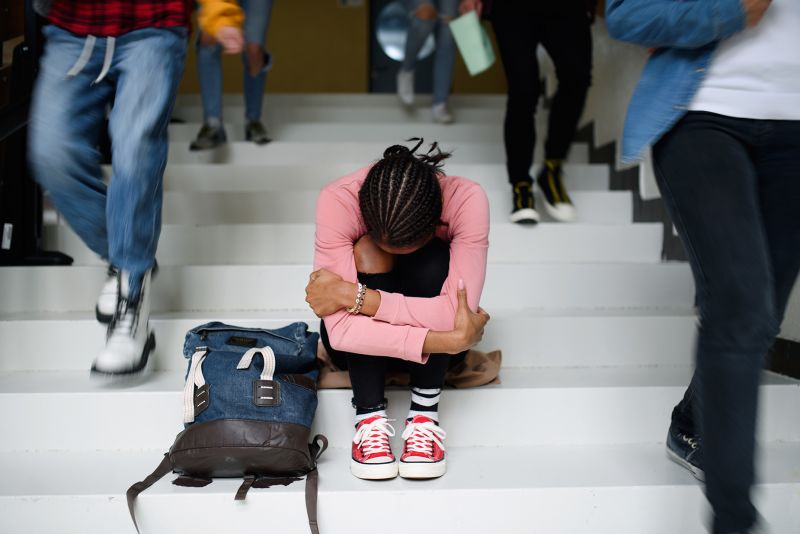Compared with a decade ago, teens, and especially girls, are more likely to say they feel persistently sad and hopeless and to think about or attempt suicide, according to a new report. Still, recent data suggest things might be improving slightly since the pandemic.
The report, the Youth Risk Behavior Survey, which has been fielded by the US Centers for Disease Control and Prevention for more than three decades as a way to measure the well-being of American high school students, found a two-point improvement in the percentage who said they experienced persistent feelings of sadness or hopelessness from 2021 to 2023, the most recent years measured by the survey. But overall, the outlook for teens is still pretty dark.
In 2023, 40% of students who answered the survey said they experienced persistent feelings of sadness or hopelessness. That metric was down from a high of 42% in 2021 but is still about 10 percentage points higher than it was a decade ago.
In addition, 20% said they seriously considered suicide, up from 17% in 2013. Nine percent said they had attempted suicide; that’s down from a high of 10% in 2021, but still higher than the 8% reported in 2013.
The latest round of the survey was completed by more than 20,000 students in grades nine through 12 from a nationally representative sample of 155 schools.
“The numbers are telling us that our youth are suffering, and we have a mental health crisis going on,” said Dr. Jill Emanuele, vice president, Clinical Training at the Child Mind Institute in New York City. She was not involved in the survey.
When researchers separated the numbers by sex, the picture was very different. More than half of girls (53%) said they felt persistently sad or hopeless compared with 28% of boys. In 2013, those numbers were 39% for girls and 21% for boys.
“Girls are definitely struggling more,” said Emanuele, who also noted that the differences between sexes may not actually be as wide as they seem. “Girls are more verbal and vocal about some of their challenges, traditionally, boys are not as much, although I think that is changing.”
Researchers at the CDC said that while the recognized the severity of the issues, they were hopeful about recent improvements in some of the metrics measured in the survey.
“We are not out of the woods by any stretch. We are still, I believe, experiencing a crisis in mental health among young people,” said Dr. Kathleen Ethier, director of CDC’s Division of Adolescent and School Health. “But when we look at the data from 2021 to 2023 we’re starting to see these glimmers of hope.”
Some of the biggest improvements in persistent feelings of hopelessness over the past two years had been among multiracial, Asian and Hispanic students.
And Ethier said she was happy to see that the number of Black students who reported attempting suicide in the past two years had gone down.
“In 2021, the percent of students who said they attempted suicide among Black youth was also coinciding with some really disturbing data around mortality to suicide among young people of color, and so we’re hopeful that in seeing that fewer Black youth are attempting suicide, that hopefully we’ll also see the same similar decreases in mortality,” Ethier said.
Even as there were slight improvements, the survey showed some groups are suffering more than others. About half of kids who identify as gay, bisexual, transgender and queer said they experienced poor mental health in the last month, and this group was far more likely to report suicide attempts and experience violence.
“We are still seeing really substantial disparities for LGBTQ+ youth in experience of violence and poor mental health and suicidal thoughts and behaviors that remains a huge concern for us,” Ethier said.
Emanuele said the numbers for LGBTQ+ kids were not a surprise, but they were disheartening to see.
“Youth from the LGBTQ+ population absolutely report higher levels of mental health challenges because they are trying to operate in a society that, across the board, doesn’t accept them,” Emanuele said, “So I mean, when you have to deal with it on a regular basis … that’s a real challenge to your mental health.”
Emanuele said the crisis continues to be exacerbated by a lack of mental health resources and providers for kids and teens, but parents can help.
“We all want children to have some kind of mental health literacy, and we don’t want it to all come from TikTok,” she said.
Parents should start by educating themselves with trustworthy online resources. Talking to their teens to open a channel of communication is a worthwhile first step, she said.
“Being able to to say, ‘How are you feeling? What’s going on? And to be able to dialog that together, that’s one of the first things, I think,” she said.
